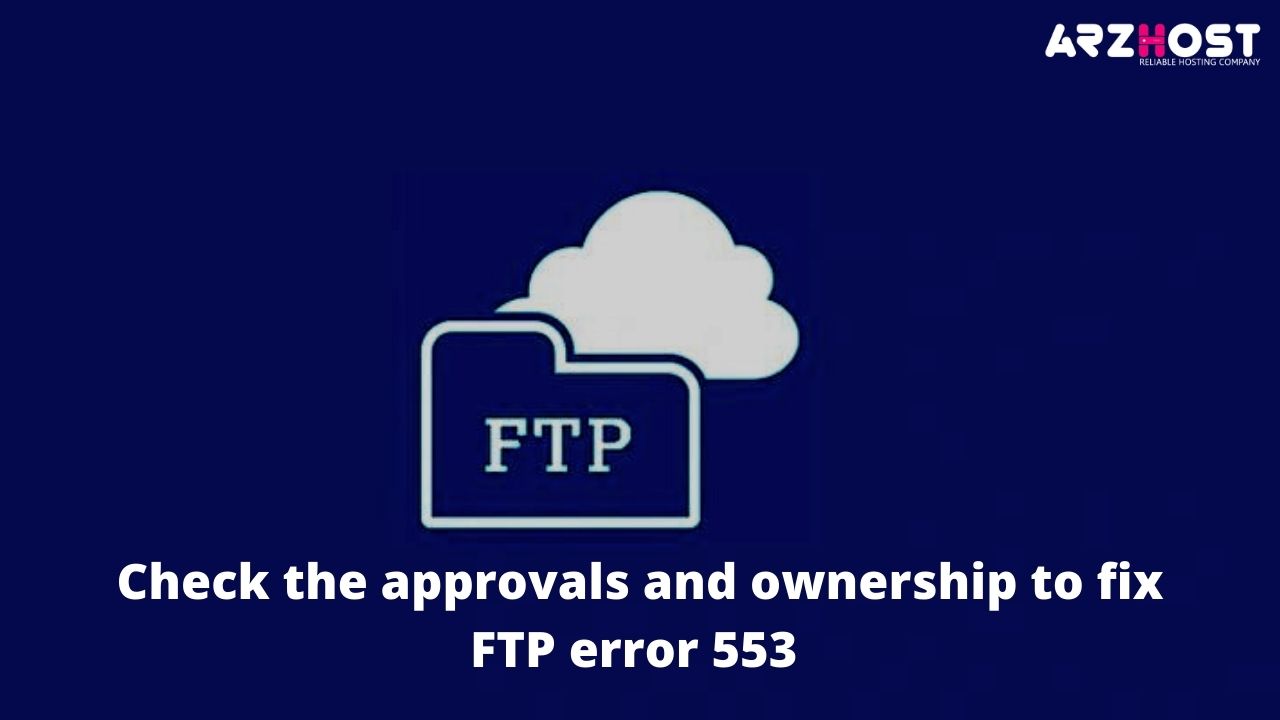FTP error 553 is one of the ordinary missteps that we go over while moving records through FTP. Errors on your WordPress site can tone down your work and make real weights for both you and your customers.
For instance, the “Foundation failed: couldn’t make list” message can hold you back from giving an essential component or handiness. This is generally caused on account of some improper approvals set to the records. “FTP Could Not Create File”, Or on the other hand, no doubt the FTP clients like vsftpd don’t allow any exchange.
Around here at ARZHOST, we routinely get sales to fix FTP errors as a piece of our Server Management Services. Today, we should discuss this 553 screw-up in FTP and see how our Hosting Expert Planners fix it.
What does FTP error 553 illustrate?
“FTP Could Not Create File”, The error 553 exhibits that referenced move not made or File name not allowed.
Generally, the screw-up 533 shows up while moving any records in the FTP. Again unique FTP clients show different varieties of the error message. For instance, FTP request brief error appears as:
- ftp> put/home/customer/Desktop/FTP/2.jpg
- close by:/home/customer/Desktop/FTP/2.jpg remote:/home/customer/Desktop/FTP/2.jpg
- 227 Entering Passive Mode (192, xx, 134,131,24,92).
- 553 Could not make the report.
- ftp>
Presenting a New Theme or Plugin on Your Site
Your WordPress site is included two sections: an informational collection and various reports that are taken care of on a server in ‘indexes.’ When you use WordPress overseer to add a theme or module to your site, it needs to make another vault where to save its records.
Regardless, if the module or subject you’re trying to explain doesn’t have approval with write in your site’s root record. I won’t have a choice to finish this work. That is where you’ll see an error, for instance. “FTP Could Not Create File”, “Foundation failed: couldn’t make vault.”
This error is your server’s strategy for saying that you’re not allowed to make changes to your site’s reports by adding the module or subject being referred to. All around, this is an issue that typically occurs on new WordPress objections.
Note that there is a practically identical, more surprising justification behind this error. Accepting that your server is running out of plate space to store your site’s records. “FTP Could Not Create File”, may show this identical message since it has no space for the new module or subject.
Stimulating an Existing Theme or Plugin
Every so often, when attempting to upgrade a WordPress subject or module that is at this point presented on your site, you may see an error as old as one we’ve shown beforehand. This one will routinely examine, “Update failed: couldn’t make vault.”
This issue occurs for the same reasons as the “Foundation failed couldn’t make file.” error. Right when you update a WordPress module or subject, WordPress needs to change its records on your site’s server. If your assents settings are off base or there isn’t adequate free space, the cycle cannot get aside reports or move new ones.
Since the justification for these two issues is almost identical, the courses of action are unclear as well. “FTP Could Not Create File”, Any systems for settling the “Foundation failed: couldn’t make list” error recorded underneath should similarly work for a dialed back to update.
Moving Files to the wp-content directory
Server report approvals are security incorporates that working with providers put to prevent unapproved parties from making changes to your site or taking fragile information. Still, they can once in a while keep you out of your records if they aren’t set viably.
This is the explanation, expecting you endeavor to get around the “Foundation failed: couldn’t make list.” error in your WordPress dashboard by moving the module’s or then again subject’s archives clearly to the wp-content list on your server, you’ll likely still experience a comparable issue. The error occurs considering an issue with your server, not your WordPress foundation.
This issue may moreover loosen up to your wp-content/moves subdirectory, where all of your media archives are taken care of. Adding pictures, accounts, or relative substance to your site by saving them to your server follows a comparable connection as presenting another module or subject.
Accepting you don’t have the approval to write in your root library, moving substance to wp-content/moves will regardless convey the error we’ve been looking at. “FTP Could Not Create File”, To fix it, you’ll need to change your server’s settings, as we’ll depict rapidly.
Purposes behind FTP error 553
We should now be careful with the significant purposes behind 553 errors in FTP.
1. Mistaken approvals
Usually, FTP error 553 can happen as a result of awful agrees set to the standards and envelopes. “FTP Could Not Create File”, If the moving records don’t have to make approvals, then, it will end up with errors.
It is very principal to have the form approvals set to the standards with the objective that we can make changes to the record by moving any substance to it. Moreover, the customer should enjoy enough benefits to forming the reports to the genuine list too.
2. Errors in the arrangement of vsftpd
This error also happens as a result of a mistaken course of action of FTP clients like Vsftp. By the day’s end, any off-base informational index in the planned archive brings about such errors.
For example, the value of write enables in the vsftpd. conf ought to be set to likely with license forming. Regardless, normally, it is set to sham. This makes issues and ends up in 553 errors.
“FTP Could Not Create File”, We normally, guarantee that the FTP client arrangement is set suitably with the true hints.
How do we fix FTP error 553?
Having a period of capacity in server the board, our Hosting Expert Planners are familiar with these FTP errors.
“FTP Could Not Create File”, We should now discuss different circumstances where we experienced this screw-up and how we fix it.
1. Check the approvals and ownership to fix FTP error 553
One of our customers made a customer and was viably connected with FTP. “FTP Could Not Create File”, However, while trying to move a couple of substances into the record, they got an error
229 Entering Extended Passive Mode (|||12011|).553 Could not make the record.
Our Hosting Expert Planners started researching the error by truly studying the approvals of the archive. We could see that the approvals were fixed. Thusly, then, we tried to change the obligation regarding the coordinator to which customer was trying to move the substance using the request:
chown USER: GROUP folder name
Finally, after this change, the customer had the choice to move the substance sufficiently.
2. Mixed up worth in the arrangement record.
Lately, “FTP Could Not Create File”, one of our customers moved closer with a slip-up message
553 Could not make the archive
Our Hosting Expert Planners started exploring the screw-up by really taking a gander at the approvals of the records. We saw that the agrees were all set right. Later we went checking for the arrangement record vsftpd. conf. Here, we considered the underneath line
guest enable=YES
Expecting this guest enable is set to YES, it will throw 553 Could not commit archive error. Thusly, we set the guest to enable value to NO. This is because the FTP server will consider all the logins as a guest login.
In this way, it will end up throwing error messages. “FTP Could Not Create File”, Finally, this good the error resulting to changing the value of guest enable from YES to NO.
Termination
To lay it out simply, the FTP error 553 happens for the most part in light of the improper approvals set to the archive and on account of the mistaken nuances in the FTP client arrangement.
Save time, costs and extend site performance with:
- Second assistance from WordPress working with subject matter experts, the entire day, consistently.
- Cloud flare Creativity joining.
- The overall group reaches with 29 server ranches throughout the planet.
- Smoothing out with our certain Application Performance Monitoring.
To choose whether a record approvals issue is causing a module or theme foundation error on your site. “FTP Could Not Create File”, You can use the Site Health tool or check out your server’s error log.
Starting there forward, resetting your assents using FTP/SFTP ought to simply require several minutes. Today, we saw how our Hosting Expert Planners fix this slip-up.
People Also Ask
Question # 1: Where are vsftpd files stored?
Answer: Of course, vsftpd searches for this record at the area/and so forth/vsftpd. conf. Notwithstanding, you might abrogate this by indicating an order line contention to vsftpd. The order line contention is the pathname of the setup record for vsftpd.
Question # 2: Where does FTP get put files?
Answer: Whenever you are signed in, your present working registry is the distant client home index. When downloading records with the FTP order, the documents will be downloaded to the index from which you composed the FTP order. Assuming you need to download the records to another neighborhood index, change to it by utilizing the LCD orders.
Question # 3: Why is FTP connection refused?
Answer: The client’s Windows Firewall is impeding the port. The FTP customer is not designed for the right host data. The FTP customer is not designed for the right port. Assuming that the Server network is designed to just permit explicit IP locations to associate, the client’s IP address has not been added.
Question # 4: What is an FTP server used for?
Answer: In the least complex of definitions, an FTP Server (which represents File Transfer Protocol Server) is a product application that empowers the exchange of documents starting with one PC then onto the next. FTP is a method for moving records to any PC on the planet that is associated with the web.
Question # 5: What communications model does FTP use?
Answer: customer server model design
The File Transfer Protocol (FTP) is a standard correspondence convention utilized for the exchange of PC documents from a server to a customer on a PC organization. FTP is based on a customer server model design utilizing separate control and information associations between the customer and the server.










